How do you currently plan and organize your content creation process?
Are you a fly-by-the-seat-of-your-pants kind of writer, or do you have a master plan in place?
Let’s dive into the world of content and learn more about the editorial calendar to revolutionize your workflow.
What is an editorial calendar?
An editorial calendar is your go-to planning tool for organizing and scheduling your content across various platforms.
Think of it as the perfect blend between your personal assistant and a well-thought-out blueprint for your content game.
With an editorial calendar by your side, you can effortlessly manage deadlines, streamline your creative process, and stay on top of your content creation like a true pro.
No more last-minute panic or haphazard content planning.
So, gear up for a smoother, more efficient content journey with this trusty tool!

Editorial calendar vs content calendar
While the two terms may seem interchangeable, they actually serve distinct purposes in the realm of content management.
An editorial calendar, as we’ve mentioned, is your strategic partner in crime, focused on planning, organizing, and scheduling your content across platforms. It helps you maintain consistency and ensures your you produce content that aligns with your brand’s voice and goals.
On the other hand, a content calendar is a more comprehensive tool that encompasses not just the planning and scheduling aspects, but also the tracking and analysis of published content. It’s like your all-in-one command center, keeping tabs on the entire content lifecycle, from ideation to publication and performance monitoring. A content calendar is an effective way to ensure that you are creating and publishing eye-catching and attractive pics for your social media and websites regularly.
So, while both calendars are invaluable for content creators, the editorial calendar is your guiding star for planning and organizing, whereas the content calendar provides a broader view of the content pipeline, covering every stage of your content’s journey.
What are the benefits of using an editorial calendar?
Now that you got an idea of what an editorial calendar is, let’s dig out the benefits it brings to your content creation process.
- Consistency: You can maintain a steady flow of content, keeping your audience engaged and informed.
- Organization: Helps you keep everything in one place, making it easy to manage deadlines and avoid content overlaps.
- Collaboration: Fosters seamless collaboration, ensuring everyone’s on the same page and contributing effectively to content production.
- Strategy: Allows you to take a step back and view the big picture. This bird’s-eye view helps you develop a more intentional and goal-oriented strategy for your content.
- Time management: Allocate your time and resources more efficiently, minimizing last-minute stress and maximizing productivity.
How to create an editorial calendar

Time to craft your very own content marketing editorial calendar! Follow these simple steps to create a powerful and efficient tool tailored to your content needs:
- Identify your target audience: Start by pinpointing who you’re creating content for. Knowing your audience helps you tailor your messaging and keeps your content relevant and engaging.
- Set goals and objectives: Determine what you want to achieve with your content. Are you aiming to increase brand awareness, generate leads, or educate your audience? Setting clear goals helps you stay focused and measure success.
- Choose content formats: Figure out which formats resonate best with your audience – blog posts, podcasts, videos, infographics, or something else? Don’t be afraid to mix it up and experiment with different formats!
- Develop a content plan: Based on your goals and formats, brainstorm content ideas and map them out on your calendar. Consider important dates, events, or product launches to create timely, relevant content.
- Assign tasks and deadlines: Allocate responsibilities to your team members (if you have them) and set realistic deadlines for each piece of content. This helps keep everyone accountable and ensures a smooth workflow.
- Regularly review and optimize: Periodically assess your editorial calendar’s effectiveness. Analyze your content’s performance, gather feedback, and make adjustments as needed to keep your strategy fresh and relevant.
How do you use an editorial calendar to plan your content?
- Start with a content audit: Evaluate your existing content to identify gaps, successes, and areas for improvement. This will help you make informed decisions while planning your future content.
- Consider your content pillars: Identify key themes or topics that are central to your brand and audience interests. These will act as the foundation for your content plan.
- Brainstorm content ideas: Gather your team (or put on your thinking cap) and generate ideas that align with your goals, audience, and content pillars. Challenge yourself to think outside the box!
- Schedule your content: Map out your ideas on the editorial calendar, ensuring a balanced mix of content formats and topics. Keep your audience’s preferences, industry trends, and important dates in mind while scheduling.
- Plan for promotion: Don’t forget to include a plan for promoting your content across various channels, like social media, email newsletters, or guest blogging. Incorporate these promotional activities into your calendar.
- Track progress and adapt: Monitor your content’s performance and gather insights that will help you refine your strategy. Adjust your calendar as needed to keep your content fresh and engaging.
What should you include in your editorial calendar?

When crafting the editorial calendar, it’s essential to include the right components that will help you stay on track and efficient. Among the most important components are:
- Content title or topic: Clearly indicate the main idea or theme of each piece of content to navigate easily.
- Content format: Specify the format of your content, whether it’s a blog post, video, podcast, infographic, or something else, to help plan your resources and timeline accordingly.
- Publish date: Set a target date for when you want to publish your content, which will help you stay on track and manage deadlines effectively.
- Author/creator: If you’re working with a team, note down who’s responsible for creating each piece of content to ensure accountability and smooth collaboration.
- Status: Keep track of the content’s progress (e.g., idea, draft, in review, or published) to monitor your workflow and stay up-to-date on each piece’s stage.
- Distribution channels: Note down the platforms where your content will be published or promoted, such as social media, email newsletters, or guest blogging opportunities.
- Promotion strategy: Outline your plans for promoting your content, including any social media posts, paid advertising, or influencer collaborations.
- Performance metrics: Include a space for tracking key performance indicators (KPIs) that align with your content goals, like page views, shares, or conversions.
How far in advance should you plan your editorial calendar?
To help you plan effectively, here are some general guidelines:
Short-term planning
Aim to have your content planned at least one month in advance. This gives you enough time to create, review, and edit your content without rushing, while still staying nimble enough to adapt to emerging trends or opportunities.
Mid-term planning
For more extensive projects or marketing campaigns, you may want to plan 3-6 months in advance. This allows you to allocate resources, coordinate with your team, and build a cohesive strategy of content around specific goals or events.
Long-term planning
You can also establish an annual or bi-annual overview of your content strategy, which includes key themes, objectives, and important dates. This high-level planning helps you stay aligned with your goals and ensures a consistent content flow throughout the year.
How can you collaborate with your team on an editorial calendar?

Collaborating with your team on an editorial calendar is all about effective communication and leveraging the right tools. The quick rundown below can help you to get everyone on board and working together:
- Choose a collaboration-friendly tool: Pick a platform that allows real-time updates and easy sharing, like Google Sheets, Trello, or Asana, so your team can access and contribute to the calendar effortlessly.
- Assign responsibilities: Clearly indicate who’s in charge of creating, editing, or approving each piece of content. This ensures accountability and helps streamline the workflow.
- Schedule regular check-ins: Set up weekly or bi-weekly meetings to review progress, discuss any challenges, and share ideas to keep your team engaged and aligned with the content plan.
- Encourage open communication: Foster a collaborative environment by encouraging team members to share their thoughts, feedback, and suggestions to improve the content creation process.
How often should you update your editorial calendar?
The frequency of updating your calendar can vary depending on your content goals, the size of your marketing team, and the platforms you’re working with. However, you can advise the following general guidelines to help you stay on track:
Short-term updates
Aim for weekly check-ins to review your upcoming content, ensure deadlines are met, and address any last-minute changes or emerging opportunities. This keeps your calendar current and your team in the loop.
Mid-term reviews
Consider a monthly or quarterly review to assess your content’s performance, gather insights, and adjust your content plan accordingly. This helps you stay aligned with your goals and adapt to changing trends or audience preferences.
Long-term planning
Conduct an annual or bi-annual evaluation to reflect on your overall content marketing strategy, identify successes and areas for improvement, and set goals for the upcoming year.
Remember, the key is to strike a balance between being flexible and maintaining a more consistent schedule and content flow. By regularly updating your editorial calendar, you’ll ensure your content remains relevant, engaging, and goal-oriented.
Tips for using an editorial calendar effectively

To enable you to be organized to the maximum, we share some quick tips to help you use the calendar effectively and efficiently:
- Be realistic: Set achievable deadlines and goals, considering your team’s capacity and available resources to avoid burnout and last-minute stress.
- Stay flexible: While planning is crucial, leave room for adjustments to accommodate new opportunities, trends, or shifting priorities.
- Keep it organized: Use color-coding, tags, or filters to categorize your content by format, topic, or status, making your calendar easy to navigate and manage.
- Monitor performance: Regularly track your content’s success using relevant KPIs, and use these insights to inform your future content strategy.
Tools and resources for creating an editorial calendar
A good content marketer has always the right tools and resources in place to be prepared for planning and executing the strategy. You shouldn’t be an exception.
This concise list of helpful tools and resources can be beneficial while you create your editorial calendar. It includes content marketing software and social media scheduling tools:
Google Sheets
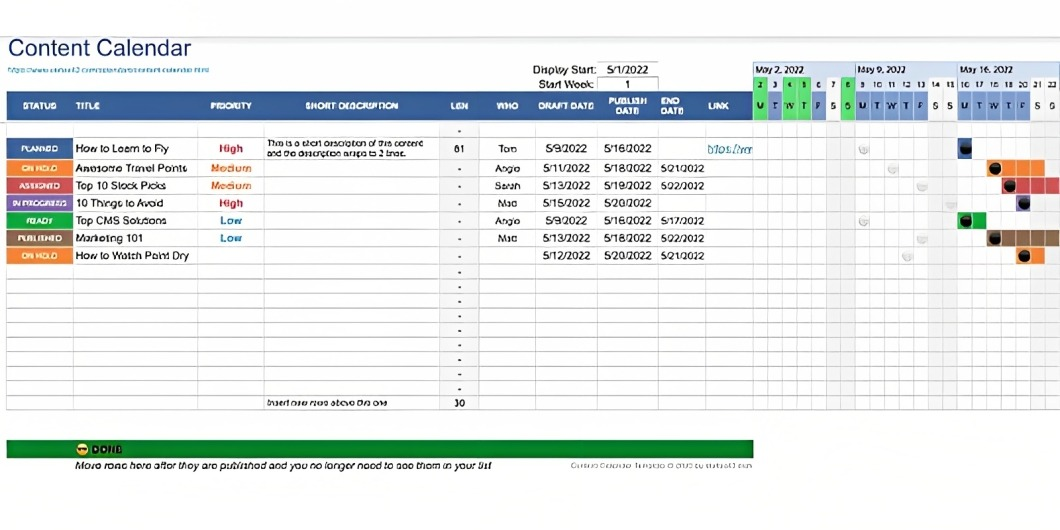
Google Sheets is a free and user-friendly option for real-time collaboration, perfect for small teams or basic content planning needs.
Trello
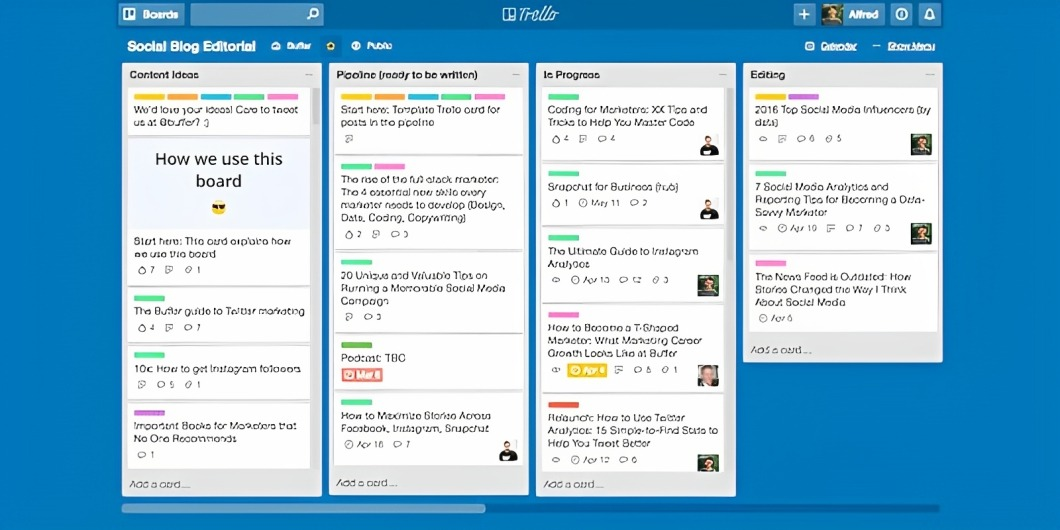
Trello is a versatile, visual tool offering boards, lists, and cards to manage your content workflow and collaborate seamlessly with your team.
Asana
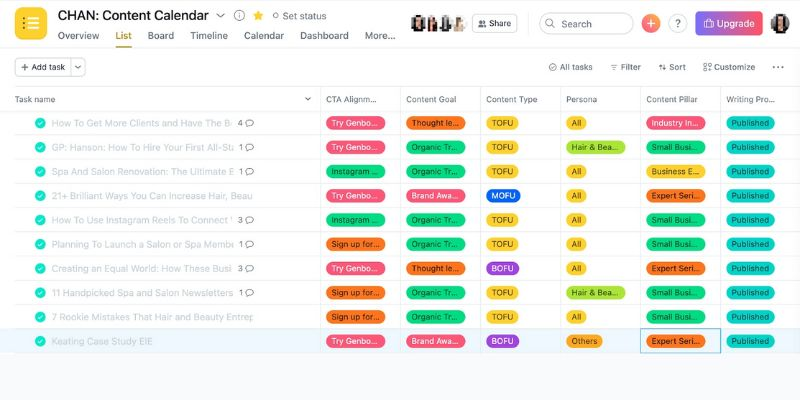
Asana is a powerful project management software platform with calendar views and advanced features for planning, scheduling, and tracking your content efficiently.
Airtable

Airtable is a flexible and highly customizable spreadsheet-database hybrid tool, that allows you to create an editorial calendar tailored to your unique, content production needs.
Buffer
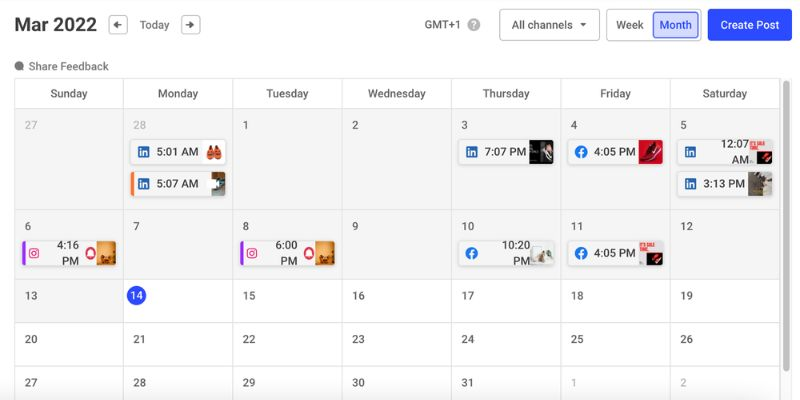
Buffer is another widely-used social media scheduling tool that helps you plan, collaborate and publish your content consistently and effectively.
Searching for an editorial calendar template?
Here are two choices to think about if you’re looking for the greatest free editorial calendar templates now available:
HubSpot’s editorial calendar template
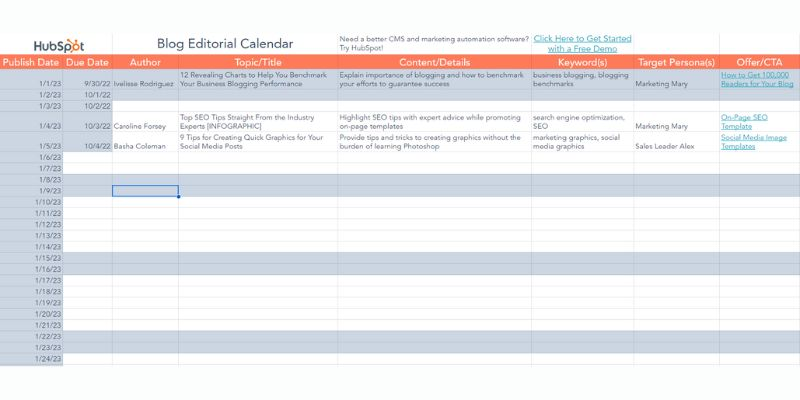
A thorough, user-friendly tool for all content managers and producers that is accessible in both Google Sheets and Microsoft Excel. It allows you to plan content, set deadlines, assign tasks, and track progress easily.
You can download the free template here.
Content Marketing Institute’s editorial calendar

A useful, streamlined template that emphasizes important factors like content themes, publish dates, and target audiences.
You can download the template here.
Examples of editorial calendars
Looking for inspiration?
We listed three examples of editorial calendars from different industries to give you an idea of how various organizations plan their content.
Fashion Magazine
A fashion magazine’s calendar might include seasonal trends, designer features, and photoshoots. Their calendar could plan content around fashion weeks, holiday style guides, and exclusive interviews with industry influencers.
Tech Blog
A tech blog’s calendar might focus on product reviews, industry news, and how-to guides. They could schedule content around major tech events, like CES or WWDC, and plan in-depth analyses of emerging technologies and startups.
Health & Wellness

A health and wellness company might create content around nutrition, fitness, and mental well-being. Their calendar could plan articles social posts, and videos in sync with national health awareness months, seasonal fitness challenges, and expert interviews on various wellness topics.
These examples showcase different approaches to planning an editorial calendar based on the unique goals marketing objectives, personas, and content types specific to each industry. Use these examples as inspiration to tailor your editorial calendar to your own niche and objectives.
Final Thoughts
Utilizing an editorial calendar is essential for streamlining your content creation process and keeping your team organized.
By planning and managing content effectively, you’ll be better equipped to reach your marketing goals and engage your target audience.
The benefits of a well-maintained editorial calendar are countless, from ensuring consistency and accountability to making data-driven decisions that drive success.
So, don’t wait any longer—start building your editorial calendar today and unlock the full potential of your content marketing efforts.
Feeling stuck?
Or want a second opinion?

You can have a 1:1 call with a mentor specializing in content marketing.
Happy planning!
Frequently Asked Questions
An editorial calendar is a schedule that outlines the content to be published on a website, blog, or social media platform over a specific period.
To design a content plan, choose the content format, identify your target audience, set goals and objectives, assign tasks and deadlines, and continuously assess and improve your strategy.
The timeframe for planning an editorial calendar depends on your business and your goals. Some businesses plan their editorial calendars weeks or months in advance, while others plan them on a monthly or even weekly basis.
Your editorial calendar should include the content topics, the publishing date, the content format, the responsible team member, and any other relevant details.
There are many tools and software available to help you create an editorial calendar, such as content planning templates, content marketing software, and social media scheduling tools.
An editorial calendar outlines high-level themes and topics for content, while a content calendar outlines specific pieces of content to be created and published. The two calendars can be used together to ensure that content aligns with overall strategy and goals.



